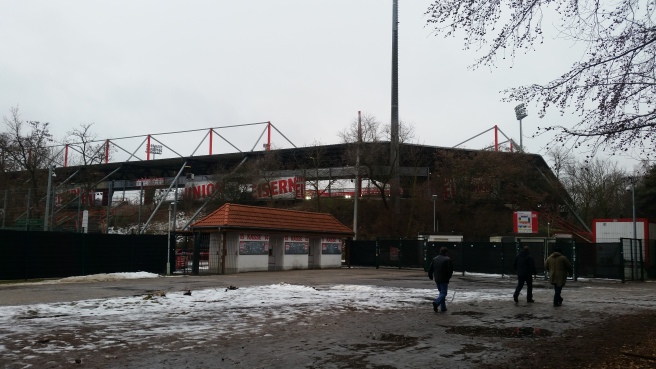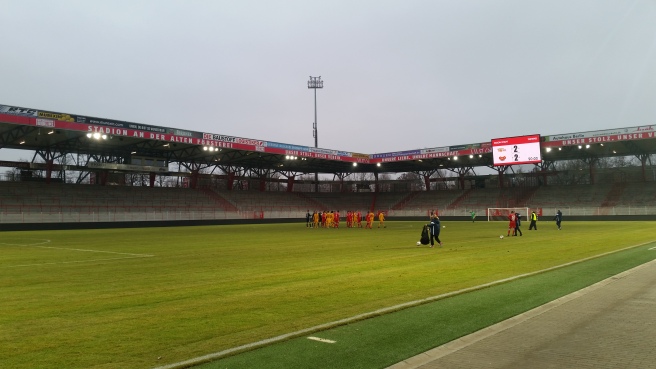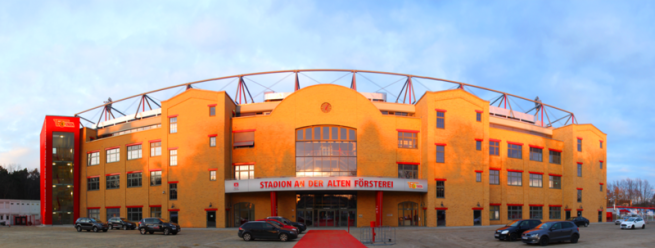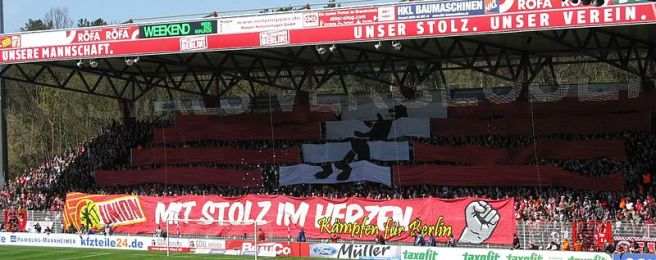We don’t think of Germany as a country that blooms culture. But the Bundesrepublik is home to its fair share of enigmatic and fascinating Football clubs, none being more mysterious or romantic than 1. FC Union Berlin. 3 key institutions combine to endow this club with its very idiosyncratic, and consequently celebrated, character; its history, its stadium and its fans.
Köpenick, the home of 1. FC Union Berlin, is a suburb of East Berlin and was part of the Communist Deutsche Demokratische Republik until reunification in 1990. The club under its current guise was born in 1966 into the strange and ludicrous world of East German sport, a world in which players were force-fed ideological doctrine whilst being transferred to other Football clubs at a moment’s notice, many of which were subject to arbitrary relocation to other cities and baffling name changes, before ultimately being handed orders from the central powers above to collude in match-fixing anyway. Everybody involved in East German Football (excluding the fans) was a potential pawn in the Communist regime’s game. The Sozialistische Einheitspartei Deutschlands (SED) understood that the nation’s most popular sport could be manipulated to win influence, spread doctrine and ultimately legitimise the regime and its actions in the minds of the East Germans.
The most notable subject club in this era was BFC Dynamo Berlin; the puppet that Erich Mielke, head of the Stasi, chose to back. The Stasi’s relationship with BFC was a known fact and no secret; most Communist national industries were related to a specific club. After having been relocated from Dresden in 1954, the Stasi-backed Dynamo club was allocated the best players available in East Germany and benefited from favourable refereeing season to season. BFC Dynamo’s 10 consecutive league titles in the 80’s are nothing more than testament to the Stasi’s meddling in the sport. Did this backing of BFC Dynamo convince the East German public of the government’s legitimacy? Did success of the Stasi backed Football club breed support from the common man? The answer is a resounding no.


Most citizens were perfectly aware of the Stasi’s efforts to manipulate the subject peoples’ realities in-and-outside of Football, albeit not quite aware to what extent. They were understandably unhappy with this; BFC Dynamo quickly became the most hated club of East Germany, a title that survives to this day. Fans were resentful of the regime’s control and abuse. The same way in which Erich Mielke and the Stasi used BFC Dynamo as a propaganda vehicle, East Germans used BFC Dynamo as a vehicle against which one could (relatively) safely express dissatisfaction. But the fans who hated BFC Dynamo Berlin more than any other were those of SG Dynamo Dresden and of 1. FC Union Berlin. The Dresdeners rightly accused the Mielke of robbing them of their club. The Eisernen disliked the notion of their city being the home of these practices.
Though Union did in Communist times have links to the police force and to the workers’ union, it was long considered one of the DDR‘s “civilian clubs”, joining the ranks of FC Hansa Rostock and 1. FC Magdeburg as being a club without a formal link to a specific trade. The lack of an industrial reference in the club’s name indicates Union as a club that did not suffer the string pulling of a nationalised industry. Union’s lack of political standing facilitated guilt-free trips from the average man to watch Football; watching Union did not mark you out as being a Stasi sympathiser for example. In the long run, 1. FC Union Berlin has benefited from BFC Dynamo’s links to the Stasi in the form of high match attendance. In 2018, 1. FC Union Berlin gets high gate figures every week, whereas Berliners are still unwilling to go watch BFC Dynamo play, long after the Stasi has died.
A visit to 1. FC Union Berlin’s stadium the Stadion an der Alten Försterei (translating loosely as the Stadium at the Old Forester’s Lodge) is a joyous experience. The ground lies deep in a forest that any visitor must traverse before the structure becomes visible. In winter, this can mean a perilous icy walk. In summer, this can mean exposure to Central Europe’s staggering heat. Be brave. It is worth it. 4 banked terraces hug the carpet of grass, only one of which featuring a wall behind onlookers. The three standing sections are simply slopes with a lattice of coloured beams supporting the roof. You face the elements here, the cruel wind picks up from behind you and races through. Yet the visual effect is stunning. A pyramid for Football. Thousands of years from now archaeologists digging in an overgrown Brandenburg forest will uncover a structure as exciting as anything we find in our time on the Yucatan peninsular.


What makes the Stadion an der Alten Försterei more spectacular is the fact that it was renovated by actual Union fans. In 2008, the club management openly and humbly acknowledged the lack of funds needed to pay for the thorough renovation to bring the stadium back up to Bundesliga standard. What to do? Over 2000 fans simply volunteered throughout the 2008/2009 season to rebuild the various stands surrounding the pitch, only employing specialist tradesmen to undertake the more technically complicated tasks. This feat is rightly acknowledged by Football enthusiasts the world over. Would fellow fans of your club go to such lengths? The Eisernen truly are superlative.
This brings us nicely to the fans. Union’s image as a club for the working classes of Berlin’s East harks back to that aforementioned relationship with the DDR workers’ union and incidentally provides a tidy explanation for the Eisernen “Irons” nickname. While rivalry with Hertha BSC has undoubtedly risen in the past decade, back during the Cold War it was actually not uncommon for a few lucky East German Union fans to attend Hertha games in the West if given opportunity. What’s more, Hertha fans also took the time to attend Union games, particularly the derby against BFC Dynamo, the club that many Eisernen will still identify as their principal rival 28 years after the fall of the Berlin Wall. While neither side may like to admit it, Herthaner and Eisernen reveled in their shared underdog status.
Union fans are not unknown for criminal behaviour that many find unsavoury. 3 stories come quickly to mind. In January 2015 they clashed heavily with local Berlin police after a friendly fixture at home to SV Austria Salzburg. Half a year before that, travelling Crystal Palace fans were jumped by Union Ultras who stole a flag and displayed it cut into pieces during the game to taunt the visiting Londoners. And at their eagerly awaited cup tie away at the darling Westfalenstadion, the 10,000 strong (I’m not making that up) visiting Union Berlin fans again proudly displayed captured Borussia Dortmund fan flags and banners while alighting pyrotechnics in the away sector. These acts by no means make Union fans an exception within German Football Culture, but in the minds of many, they do help define it and indict the Eisernen as key figures within that German Football Culture.


Many other Football writers assign the strong leftist and anti-fascist brand to 1. FC Union Berlin, making it comparable to Sankt Pauli, Livorno or AEK. I’ve never really got that impression on a Saturday afternoon in Köpenick and I believe that the average Eisern will say something similar, but you of course are welcome to come to your own conclusions. Without doubt though, Union fans do come out in force regardless of how important the day’s fixture is in sporting terms. And to be in that stadium, next to those fans, among that history, is an experience that has projected 1. FC Union Berlin to the forefront of every neutral Football Groundhopper’s wishlist.
When are you going?

It’s a slight shame that the examples in the Union digressions section are not all well chosen. In the Austria case, the police lied and exaggerated what Union and Austria fans did, and in fact the police was the aggressive party. And at Dortmund, a terribly organized entrance-control situation was the key issue. The overall point stands, but a not-friendly pitch invasion at an away friendly in Stockholm would have been a better example.
LikeLike
Hey Daniel. Ah yes, the Stockholm “friendly” match. A good point, thanks for your comment.
LikeLike
Eisern Union !!
LikeLike